Summer 2019
Child Passenger Safety Changes
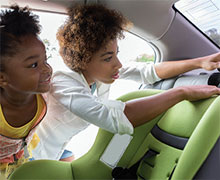 Child passenger safety guidelines are updated as new data tells us how we can best protect children in vehicles. Washington state has updated its law based on the latest recommendations from the American Academy of Pediatrics. Here are the new rules:
Child passenger safety guidelines are updated as new data tells us how we can best protect children in vehicles. Washington state has updated its law based on the latest recommendations from the American Academy of Pediatrics. Here are the new rules:
Rear-facing until at least age 2. Children under age 2 must ride in rear-facing car safety seats, and they should remain rear-facing as long as possible, until they reach the highest weight or height allowed by their seat. (Most convertible seats have limits that allow children to ride rear-facing up to 40 pounds or more.)
Then, forward-facing seats with a harness for as long as possible. Once they outgrow rear-facing seats, children must use a forward-facing seat with a harness until they reach the seat’s height and weight limits. (Many seats can accommodate children up to 65 pounds or more.)
Then, booster seats for all kids under 4 feet 9 inches tall. When children exceed the limits of a harness-style car seat, they must use a belt-positioning booster seat until they reach 4 feet 9 inches tall. Booster seats correctly position the vehicle’s lap belt low across the hip bones and the shoulder belt across the center of the shoulder. In a collision, poorly fitting seat belts are associated with injuries to the spine, intestines, head and neck. Most kids will need a booster seat until age 10 to 12.
Then, use the vehicle’s seat belt properly, and ride in a back seat until at least age 13. When children are tall enough to use the vehicle seat belt alone, they must use both the lap and shoulder belts; they must never slip the shoulder portion behind their backs. All children younger than 13 should ride in the rear seats of vehicles for the best protection, even if they are as tall and heavy as an adult.
Keep in mind that it’s generally safest to transition a child to the next stage only when they become too big for the stage they are in.
The new law officially goes into effect in 2020. However, it’s safest to adopt these rules immediately, and share the changes with others, too. It may seem challenging to keep up with the latest rules, but it’s worth it to keep your child as safe as possible!
Attend a free car seat check or visit boosterseat.org to learn more.
Paddle Sport Safety
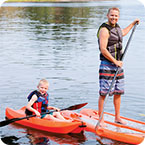 Paddle sports like kayaking, canoeing and stand-up paddle boarding are growing in popularity. They’re all fun, physically challenging activities for families, and they’re fairly easy to learn — ideally in warm weather and calm waters.
Paddle sports like kayaking, canoeing and stand-up paddle boarding are growing in popularity. They’re all fun, physically challenging activities for families, and they’re fairly easy to learn — ideally in warm weather and calm waters.
Whether you rent equipment on a local lake or while on vacation, or try it out while at a friend’s waterfront home, practice paddle-sport safety. Be sure the equipment is in good shape and you have the gear you need. Wear a life jacket with a whistle attached. Don’t go out in rough waters, and avoid areas with motorboat or jet-ski traffic. Finally, never paddle under the influence: you need to be at your physical and mental best to keep yourself and your family safe.
Visit Washington State Parks to learn more about paddle-sport safety.
Tetanus Vaccines
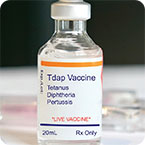 Tetanus bacteria exists naturally in soil, and it can enter the body through breaks in the skin caused by scrapes and cuts. A tetanus infection affects the muscles; it causes muscle pain and can trigger seizures and difficulty swallowing and breathing — and can even be deadly. Tetanus is also known as lockjaw, because it can cause jaw muscles to spasm and clamp the mouth tightly shut.
Tetanus bacteria exists naturally in soil, and it can enter the body through breaks in the skin caused by scrapes and cuts. A tetanus infection affects the muscles; it causes muscle pain and can trigger seizures and difficulty swallowing and breathing — and can even be deadly. Tetanus is also known as lockjaw, because it can cause jaw muscles to spasm and clamp the mouth tightly shut.
It’s crucial that your entire family is up-to-date on their tetanus vaccines. There are a few different vaccines that protect against tetanus, and they all protect against other diseases, too. The DTaP vaccine protects babies and young children from diphtheria, tetanus and pertussis (whooping cough). Kids age 11 or 12 need one dose of Tdap, which also protects against tetanus, diphtheria and pertussis. Adults then need the Td vaccine every 10 years to stay protected against tetanus and diphtheria.
Talk with your doctor to be sure you and your family are protected.
Summer Mental Wellness Tips
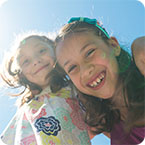 Most children feel happy and relieved when school lets out for summer. But as the days and weeks go by, they often miss the structure and built-in social time that school provides. This can cause kids to feel restless and bored — and sometimes lonely and sad.
Most children feel happy and relieved when school lets out for summer. But as the days and weeks go by, they often miss the structure and built-in social time that school provides. This can cause kids to feel restless and bored — and sometimes lonely and sad.
As parents, we can help our kids avoid the ‘summer blues.’ We can provide them with comforting structure, keep them busy and socially connected, and promote healthy habits. To create the structure kids crave, we can enforce bedtimes, provide age-appropriate chores, limit screen time and stay committed to regular family meals.
To help our kids stay busy and socially connected, we can arrange play dates with their friends, plan meet-ups at local parks and pools, and take advantage of community events and programs like festivals, camps and sports teams. Public libraries offer summer reading lists and enrichment programs. For older kids, a part-time job keeps them on a schedule, boosts confidence, builds a strong work ethic and allows them to earn their own money.
To support their overall health, we can be sure our kids get plenty of exercise and time outdoors. Summer is an ideal time for swim lessons, family hikes and bike rides. Simply taking the dog for a walk after dinner each night has a positive effect. And keep an eye on snacking; continue to avoid sugary drinks and keep lots of fruits and vegetables on hand. If you suspect your child is dealing with something more serious than the summer blues — such as depression, anxiety or ADHD — talk with your child’s doctor.
Time-Out Tips
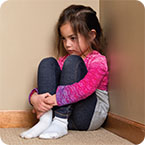 Young kids sometimes need some help to reset themselves: to reset their emotions, their attitudes and their behaviors. Used properly, a time-out is a great tool to help kids age 2 or older cool down and learn good behavior.
Young kids sometimes need some help to reset themselves: to reset their emotions, their attitudes and their behaviors. Used properly, a time-out is a great tool to help kids age 2 or older cool down and learn good behavior.
Time-outs work best if you first warn your child that a time-out will happen if a certain behavior doesn’t stop — and name the behavior. If it continues, follow through and have your child sit in a quiet place with no distractions, like the corner of a room. Then set a timer — one minute per year of age works well. If they leave before time is up, the timer starts over.
Remember, time-outs are not a punishment; they are an opportunity for a fresh start.
Learn more about discipline.
Wildfire Smoke
 Seasonal wildfires may be the new normal. Breathing in wildfire smoke is not good for anyone, and children are at extra risk for negative health effects. Infants and children under age 18 — whose lungs and airways are still developing — breathe more air per pound of body weight compared to adults.
Seasonal wildfires may be the new normal. Breathing in wildfire smoke is not good for anyone, and children are at extra risk for negative health effects. Infants and children under age 18 — whose lungs and airways are still developing — breathe more air per pound of body weight compared to adults.
For healthy people, inhaling smoke commonly irritates their eyes, nose and throat. It can cause more serious health problems for those with asthma, lung disease, heart disease and diabetes.
Be aware of air quality and heed health warnings to stay inside. Also, be sure your child’s daycare or school has an air-quality policy.
Device-Free Zones
 It’s common for parents to feel frustrated or guilty that their kids are getting too much screen time with phones, video games, television, tablets and computers. The problem is often worse in summer, when kids have a lot of free time and there’s a lack of routine.
It’s common for parents to feel frustrated or guilty that their kids are getting too much screen time with phones, video games, television, tablets and computers. The problem is often worse in summer, when kids have a lot of free time and there’s a lack of routine.
For many families, the solution is to agree on device-free zones and device-free times of day. For example: no screens at the dinner table or during meals, in bed or after a certain hour, and when visiting grandparents or doing a family activity.
Hold a family brainstorming session and start with some rules you all agree upon. Then, lead by example and embrace the change: less screen time results in more connected family time!
Quick Tip
Never leave a child alone in a vehicle, even for a minute! Set up a system to check the backseat of your car for your child every time you get out.